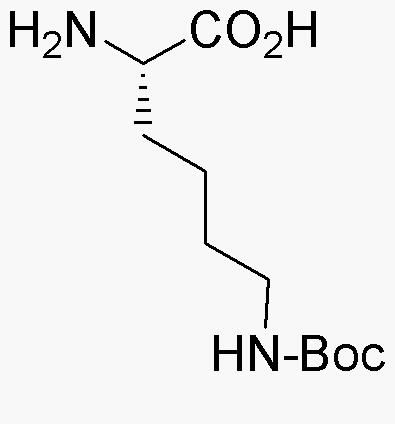Ne-Boc-L-Lysine is widely utilized in research focused on:
- Peptide Synthesis: This compound serves as a key building block in the synthesis of peptides, allowing researchers to create complex structures with specific functionalities.
- Drug Development: Its protective group facilitates the development of pharmaceutical compounds, enhancing stability and bioavailability in drug formulations.
- Bioconjugation: Ne-Boc-L-Lysine is used in bioconjugation processes, enabling the attachment of biomolecules to surfaces or other molecules, which is crucial in diagnostics and therapeutic applications.
- Protein Engineering: Researchers utilize this compound to modify lysine residues in proteins, improving their properties for various applications in biotechnology.
- Research in Molecular Biology: It plays a significant role in studies involving gene expression and protein interactions, providing insights into cellular mechanisms.
General Information
Properties
Safety and Regulations
Applications
Ne-Boc-L-Lysine is widely utilized in research focused on:
- Peptide Synthesis: This compound serves as a key building block in the synthesis of peptides, allowing researchers to create complex structures with specific functionalities.
- Drug Development: Its protective group facilitates the development of pharmaceutical compounds, enhancing stability and bioavailability in drug formulations.
- Bioconjugation: Ne-Boc-L-Lysine is used in bioconjugation processes, enabling the attachment of biomolecules to surfaces or other molecules, which is crucial in diagnostics and therapeutic applications.
- Protein Engineering: Researchers utilize this compound to modify lysine residues in proteins, improving their properties for various applications in biotechnology.
- Research in Molecular Biology: It plays a significant role in studies involving gene expression and protein interactions, providing insights into cellular mechanisms.
Documents
Safety Data Sheets (SDS)
The SDS provides comprehensive safety information on handling, storage, and disposal of the product.
Product Specification (PS)
The PS provides a comprehensive breakdown of the product’s properties, including chemical composition, physical state, purity, and storage requirements. It also details acceptable quality ranges and the product's intended applications.
Certificates of Analysis (COA)
Search for Certificates of Analysis (COA) by entering the products Lot Number. Lot and Batch Numbers can be found on a product’s label following the words ‘Lot’ or ‘Batch’.
*Catalog Number
*Lot Number
Certificates Of Origin (COO)
This COO confirms the country where the product was manufactured, and also details the materials and components used in it and whether it is derived from natural, synthetic, or other specific sources. This certificate may be required for customs, trade, and regulatory compliance.
*Catalog Number
*Lot Number
Safety Data Sheets (SDS)
The SDS provides comprehensive safety information on handling, storage, and disposal of the product.
DownloadProduct Specification (PS)
The PS provides a comprehensive breakdown of the product’s properties, including chemical composition, physical state, purity, and storage requirements. It also details acceptable quality ranges and the product's intended applications.
DownloadCertificates of Analysis (COA)
Search for Certificates of Analysis (COA) by entering the products Lot Number. Lot and Batch Numbers can be found on a product’s label following the words ‘Lot’ or ‘Batch’.
*Catalog Number
*Lot Number
Certificates Of Origin (COO)
This COO confirms the country where the product was manufactured, and also details the materials and components used in it and whether it is derived from natural, synthetic, or other specific sources. This certificate may be required for customs, trade, and regulatory compliance.


